Читать книгу The Research Experience - Ann Sloan Devlin - Страница 36
Practice Quiz
Оглавление1 Which of the following is a potentially harmful way we humans think?Category formationCommon senseHeuristicsFlexibility
2 A theory is a proposed explanation for the relationship between variables that must be tested.TrueFalse
3 Our tendency to categorize information facilitates our ability to make predictions.TrueFalse
4 In terms of sample, the _________ reflects the extent to which an array of events or objects or people reflects the characteristics of its parent population.availability heuristicconfirmation biaslogical fallacyrepresentativeness heuristic
5 One of the problems with the _______ is that we may not know the characteristics of the whole population when we think the sample doesn’t look random.availability heuristicconfirmation biaslogical fallacyrepresentativeness heuristic
6 The availability heuristic suggests that we make decisions to some extent based on how easy it is for us to think of examples from that domain.TrueFalse
7 Which heuristic was studied by asking: in words with three or more letters in English text, does the letter K appear more frequently in the first or third position?Availability heuristicConfirmation biasLogical fallacyRepresentativeness heuristic
8 When social media sites use an algorithm to post ads that agree with an individual’s political views, they are supporting the confirmation bias.TrueFalse
9 Observations lead to theories; theories can’t affect what we perceive.TrueFalse
10 What is the term for something that sounds like science but has no scientific support or evidence?Pseudoscientific thinkingGambler’s fallacyBase rateCoincidence
11 If we flip a coin and get heads, we’re more likely to get tails the next time we flip the same coin.TrueFalse
12 Superstitions are an example of the correlation does not equal causation problem.TrueFalse
13 The _______ is the frequency with which an event occurs in the population.base ratecoincidenceschemasample
14 Hasty generalization is also known as stereotyping.TrueFalse
15 Science should involve both tradition and innovation.TrueFalse
16 A schema is a mental representation of knowledge.TrueFalse
17 Scope and parsimony describe the same aspects of a theory.TrueFalse
